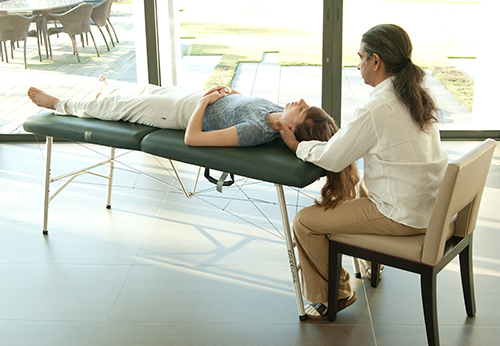Grounded in Touch: The Science Behind Anxiety Relief and Human Connection (2025)
Abstract
Background: Anxiety disorders are among the most pervasive mental health challenges worldwide, affecting individuals across all demographics and socioeconomic backgrounds. As a leading contributor to disability and diminished quality of life, anxiety continues to rise in prevalence, exacerbated by global crises and societal stressors. This study explored how Zero Balancing (ZB) supports individuals with anxiety. Researchers hypothesized that ZB would lower the perceived severity of general anxiety and reduce perceived anxiety symptoms.
Methods: A concurrent mixed-methods phenomenological research design was utilized to honor the holistic nature of bodywork and explore participants’ lived experiences. This national study involved 320 ZB sessions facilitated by 12 certified ZB practitioners trained in research methods. Each participant received one ZB session weekly for four weeks, ensuring consistency by working exclusively with the same practitioner. Anxiety levels and symptoms were gathered via pre/post-session Hamilton Anxiety Rating Scale (HAM-A) and General Anxiety Disorder-7 item Scale (GAD-7). Face-to-face, semi-guided, video-recorded interviews were conducted at the end of the series. The quantitative aspect included pre/post assessments reported with descriptive statistics and a paired samples t-test (one-tail). Qualitative data was assessed for themes.
Conclusions: Zero Balancing effectively reduced anxiety severity and symptoms, highlighting the critical role of somatic awareness in anxiety management.
Calming the Body, Calming the Mind:
A Pilot Study on the Use of Zero Balancing to Reduce Anxiety (2024)
A Pilot Study on the Use of Zero Balancing to Reduce Anxiety (2024)
Misty L. Rhoads and Mary Murphy
Abstract
Background: This study explored how Zero Balancing supports individuals with anxiety to manage their physical, mental, and emotional health more effectively. Researchers hypothesized that Zero Balancing would lower the perceived severity of general anxiety and lower perceived anxiety symptoms.
Methods: The researchers utilized a concurrent mixed-methods phenomenological research design. Each participant received one Zero Balancing session weekly for four weeks at the certified practitioners’ clinics, totaling 80 sessions for the entire study. Anxiety levels and symptoms were gathered via pre/post session Hamilton Anxiety Rating Scale (HAM-A) and the General Anxiety Disorder-7 item Scale (GAD-7). Face-to-face, semi-guided, video-recorded interviews were conducted. The quantitative aspect of this study included pre/post assessments reported with descriptive statistics and a paired samples t-test (one-tail). Qualitative data was assessed for themes.

Results: Participants reported a decline in the following anxiety symptoms: depressed mood (59%), difficulty in concentration (47%), fears (50%), somatic muscular issues (50%), and tension (49%). Four major themes emerged from the qualitative assessment: regulation, relational ease, resiliency, and wholeness.
Conclusions: Zero Balancing lowered the feeling and symptoms of anxiety. Adding the use of a skilled touch protocol, such as Zero Balancing, to the treatment of anxiety has positive benefits.

